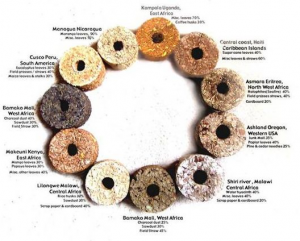Biomass Briquettes are a Biofuel Substitute to coal and charcoal. Briquettes are mostly used in the developing world, where cooking fuels are not as easily available. Briquetting or pelletizing is the process to improve the characteristics of Biomass as a Renewable Energy Resource by densification. Densification means less volume needed for the same amount of energy output.
Related Projects: - Miscellaneous Products, Projects

The advantages of biomass briquetting are by no means limited to its use in modern industrial plants or solid fuel boilers. Indeed, in developing countries a far bigger percentage of the population covers their Energy Needs with Biomass alone, where their primary need is for heat energy for cooking and heating. It is notable that biomass briquettes have played a bigger part in many projects over recent years, such as those for distributing Better Stove Technologies. Biomass briquettes can be produced out of many field or process residues and burning them in cooking appliances instead of Traditional Fuels as logged and collected wood or charcoal can be an interesting alternative for business makers but also for fuel clients.
Start a Business in Israel, Click Here
Start an Industry in Telangana, Click Here
People have been using Biomass Briquettes in Nepal since before recorded history. Though inefficient, the burning of loose biomass created enough heat for cooking purposes and keeping warm. The first Commercial Production Plant was created in 1982 and produced almost 900 metric tons of biomass.
Growth in Global Market:
According Global Biomass Briquette Market Report, Global Biomass Briquette market size is projected to reach USD 612.6 million by 2026, from USD 401.4 million in 2020, at a CAGR of 7.3% during 2021-2026.
Related Book: - The Complete Book on Biomass Based Products (Biochemicals, Biofuels, Activated Carbon)
At present, the Biomass Fuel Industry is generally at a more advanced level in developed countries. The world's large enterprises are mainly concentrated in EU. While, foreign companies have more Advanced Equipment, strong R and D capability, and leading technical level. With the development of Chinese Biomass Fuel Industry Production Technology, their share in the International Market is increasing, and competitiveness in the international market gradually increases.
Biomass Briquettes are a Biofuel Substitute to coal and charcoal. Briquettes are mostly used in the developing world, where cooking fuels are not as easily available. Briquetting or pelletizing is the process to improve the characteristics of Biomass as a Renewable Energy Resource by densification. Densification means less volume needed for the same amount of energy output.

Start a Business in Jordan, Click Here
Start an Industry in Tamil Nadu, Click Here
The most common use of the briquettes is in the Developing World, where energy sources are not as widely available.
Gujarat is the Leading State across India in Production of Briquette. Binder less biomass briquette machines are used by above 150 biomass Briquette Manufacturers based in India.
Necessary requirements to start a briquette production unit:-
· Land Requirement: Land area of minimum 1 acre is Required for Starting A Briquette Production Unit to store the raw materials for Briquetting and produced Briquettes.
· Raw materials
· Drying Facility to dry raw materials
· Shredding machine
· Briquetting machine
Related Videos: - Biotechnology, Bio-Technology, Industrial Biotechnology, Biotech Sector, Industry, Biotech Projects, Vermicompost , Biofertilizer, Organic Farming.
Reasons of Growth:
The reason biomass briquettes are used worldwide is because they are Environmentally-Friendly, Entirely Renewable, And Easy to Implement. They can be used to boil water and create steam energy, propel turbines for electricity and even heat homes and businesses.
Concern for environment can be a major reason for production of biomass briquettes globally.
Start a Business in Kuwait, Click Here
Start an Industry in Tripura, Click Here
Briquettes transformed by Biomass Waste increase density of biomass in bulk quantity, thus costs of storage, maintaining & transportation are reduced by almost 10 times, to make storage and transportation easier than fossil fuels. Various other fuel types which are quite expensive are harmful and difficult to handle. Biomass Briquettes Have a Long Shelf-Life and can be produced in a Variety of Sizes.
Biomass briquettes, as compared to the Traditional Fuels, are Economically Cheaper than Black Coal and more, because of their Less Purchase Price.
Conclusion:
Niir Project Consultancy Services (NPCS) provide detailed project reports, Books, Business Plan for Manufacturing Plant, Start-up Ideas, and Business Ideas for Entrepreneurs, etc. You can also get the detailed project report on “Biomass Briquettes Manufacture”, the project reports give reliable data on analysis of market, confirming availability of various necessities such as plant & machinery, raw materials to forecasting the financial requirements.
MamSh_2021
#DetailedProjectReport #businessconsultant #BusinessPlan #feasibilityReport #NPCS #industrialproject #entrepreneurindia #startupbusiness #BusinessIdeas #StartupBusinessIdeas #BusinessOpportunity #BiomassBriquettes #BiomassBriquettesMarket #biomassbriquettesindustry